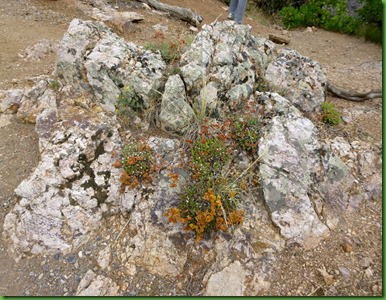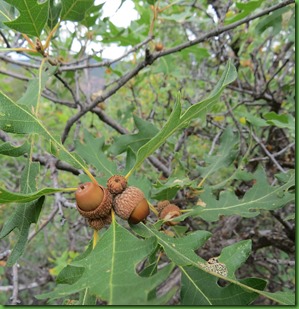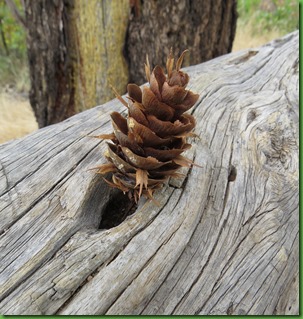Monday September 8, 2014
South Rim Campground
Black Canyon of the Gunnison
Montrose, Colorado
We are anxious to get out and see this amazing canyon so we decide to go back to the end of the drive so we can hike the Warner Trail in the daylight and see the views we missed last night. Then we will work our way back stopping at the overlooks.
The South rim elevation of 8320 feet has eliminated the need to break our days into the morning part and the evening part as we had to do in Utah. I just hope David doesn’t get us into those “overdoer days”.
It is really interesting to see this trail we walked in the moonlight last night. We really had no idea what it looked like. The clouds are sitting on the mountains in the distance as we head out.
The trail is named for Mark Warner, born in Ohio who came west in 1917 to be the pastor at Montrose Presbyterian Church. He spent a great deal of time hiking in the canyon and worked tirelessly for its preservation and was instrumental in its being set aside as a National Monument in 1933.
This is a “nature” trail and has a guide with markers along the way. It’s mostly a dirt path going over outcroppings at points. Fall colors are evident here in early September. I’m sure happy for the weather. High today is 73, low is 62. The trees are the ones we’ve seen over and over since coming into Colorado and Utah, Pinyon pines and junipers.
Junipers are the most common tree from here to California growing at elevations from 3,000 to 8,000 feet and higher. They can grow in fairly impossible conditions: poor soil, intense heat, bitter cold and prolonged drought. They are really tough and grow very slowly. A seedling with a two foot tap root could be several decades old. I love their gnarly contorted shapes and can’t help but want to touch their twisted shaggy surface which has been dried by the sun and whipped by the wind.
The juniper has been part of the tradition of peoples of the west for thousands of years. its bark has been used in making rope, sandals and other clothing, the berries for food, the wood for timbers in prehistoric dwellings and utensils. I would suspect that the wooden door frames on the granaries we saw in Arches National Park must be juniper. Because of its heartwood that is tinted a deep red, early white settlers called it cedar which it is not although it has an unforgettable fragrance all its own.
Along the trail we can see the north rim off to the side. The West Elk Mountains in the distance were once active volcanoes. The lava flows and ash settled in layers over the land. The West Elks exploded for millions of years and piled thousands of feet of ash upon the region. Two million years ago, the Gunnison river began carving into the crystalline rock that makes up the walls of the Black Canyon. Age after age it carved into some of the oldest rock in North America. I am very sad about the dams that no longer allow the river to continue its natural process.
The pinyon pine,on the left in this picture, was and is a traditional food source for Native American. Our information tells us that all the proteins needed by the human body can be found in the pinyon nut. One pound has 2880 calories the same as in a pound of chocolate. Hmmmm now there is a decision. Although the pinyon nuts are high in polyunsaturated fat and rich in vitamins and minerals. They are the name sake for the pinyon jay who along with the Clark’s nutcracker may cache as many as 30,000 pinyon nuts during a year for later needs. Some of these of course propagate the species. Nature is amazing. These birds and the trees are coevolving together. The pines appear to have evolved cone and seed structures and fruiting times that increase the chance for their seeds to be buried/planted by the birds. The pinyon pine needs almost 26 months to produce the next generation of seeds. Clark's Nutcracker has evolved both a long, sharpbill for use in prying the pine seeds from their cones, and a special pouch under the tongue for carrying them.
We come to trees that have some serious scars. Apparently porcupines eat the inner bark of pine trees in the winter when their summer food supply of leaves, seeds and plants disappears. The inner bark, called cambium, is rich in energy. Western trees including the Utes stripped bark from various trees to get the inner lining for food. Apparently they were careful to take only a little from any single tree since stripping the bark in a ring around the tree will kill it. No sense in killing your food source when moving from tree to tree allowed them a continued source of cambium. Porcupines are not always so wise.
Along the trail we are seeing the colors of fall even though it is only the beginning of September. But the most striking is when we come to a path a path lined with sage and Gambrel Oak. It is a vision for the eyes and the nose. I deliberately brush up against the large big sage to release their scent. I have wanted them in my garden since my first trip west in the 70’s but these dry loving plants would be very unhappy in the Virginia humidity or now in a pot in Winnona I fear.
It’s hard to imagine that this little “scrub” oak is a close relative of my favorite Virginia tree, the mighty white oak. The Gambrel is stunted and spindly like a shrub in part because the root system is similar to a potato. Many stems can shoot up from the root system, which causes the tree to grow as a thicket. But its leaves and acorns show the close resemblance.
When we approach a very large pinyon pine tree, our guide book tells us that the trees at Warner and High Points (the end and beginning of this trail) and some on the north rim are in the range of 750 to 850 years old. These trees were seedlings when the Ancestral Puebloans built their dwellings at Mesa Verde or when the Magna Carta was signed in England in 1215. That is just amazing to me. I am so thankful to Mark Warner whose foresight in the early 20th century helped to preserve them and this canyon.
At the end of the trail are the Douglas Firs. They don’t grow on the south side of this ridge. The climate on the north facing canyon side is a little cooler and holds moisture longer. These conditions allow the Douglas fir to populate the south rim slopes. We see their interesting cones and wonder what has caused this stripping of the bark and the sap.
There is a trail down into the canyon from here but it is steeper than we want to go and requires a permit to go through the wilderness section of the park.
The views into this deep canyon from Warner point are simply beautiful. The colors of the rocks, the ribbons of stone through them, the river at the very very bottom just spectacular. How I wish it was still free to continue the carving of this canyon that it has done for centuries. There must be a better way to provide than harnessing our rivers.
We enjoy seeing the trail from the opposite direction on our way back. It’s a 3 mile round trip and as is typical for us, when we are in no hurry, it has taken us 3 hours to do it. I would definitely like to do other trails both by moonlight and then in daylight or perhaps the other way around just to see which I prefer.

























You too are providing information for us in the West! I have not been to Colorado Monument yet, but there is no doubt in my mind that I need to go thanks to your blog!
ReplyDeleteIt is amazing how many varieties of oak there are, and how different they can be from each other. Never ceases to fascinate me!
Great shot of the Clarks Nutcracker!
Do you know why it is called the Black Canyon? It has so many beautiful colors, but I don't see black. Great writing - I always learn something new when I read your blog!
ReplyDeleteHmmm did you see the same Canyon I did? It's made mostly out of black Gneiss. Looked black with great colors in it to me.
DeleteI have to see this canyon for myself someday. Gorgeous images!
ReplyDeleteDon't know why someone planted a Douglas Fir in front of my childhood house in Chicago, but they did. And it grew! It's gone now, but I sure liked it as a kid.
ReplyDeleteThe canyon photos are so impressive, and I'd love to see them for myself.
ReplyDeleteI had Gunnison in my sites for my next trip to the west which was not meant to be. So glad to read and see it through your eyes.
ReplyDeleteJuniper & Pinyon woodlands offer a bounty of food options. Hardly any ripe enough cones for pine nuts here this year. I think these Doug firs have been hit by lightning. Marvelous to walk this trail by moon and sun light.
ReplyDeleteAwesome photos.
ReplyDeleteWhere are the pictures of you hugging the Pinyon and Juniper trees? They'll feel left out if you didn't give them a hug! ;c)
ReplyDeleteWe only saw Black Canyon from the rims as we had the dogs with us. We will have to go back and do the hikes down, it is neat to see from a different angle. The ranger here totally agreed with us abut dog owner discrimination :-)
ReplyDeleteGreat hike:) Sure makes us want to go back.
ReplyDeleteSage smells great! Beautiful canyon pictures. That pinyon nut sure packs power. Wow! I'm always impressed with trees so old and that can live in such dry environs.
ReplyDeleteLove that part of CO, at one time we were seriously considering property there. Love pine nuts, usually have some in stock. Now I see what we missed in our quick stop there, thanks for the tour.
ReplyDeleteGreat description of this trail. It's the only one we had time to do. Fun to do it through someone else's eyes!
ReplyDeleteLove the picture of the Clark's Nutcracker -- looks like he's pouting. The trail into the canyon must've been mighty steep since you guys are fearless! :-)
ReplyDeleteBeautiful canyon. Another great place I've never heard of and now have to see :-) I have great night vision so a full moon hike sounds wonderful, even with cloud cover. For nutrition and fuel, the pinon nut seems pretty perfect - must not taste too great or they'd be in all the power bars :-). Glad they're able to just grow in peace with their partners the Clark!
ReplyDeleteWe haven't been here yet but I have it on my list!! Love you photos of the beautiful rock in the canyon:) I really need an army of rangers to hike with me to explain why for all those questions I have, like your bark questions. I really like to know.
ReplyDeleteI don't mind an out and back hike. Things are so different each way especially in the west.
Beautiful place and wonderful, informative post!! Love the Clark's Nutcracker. So cool how nature provides just what is needed for the animals and how the animals don't destroy what they need to survive!!! The marbled Canyon walls are AMAZING:o))
ReplyDeleteColors in nature are gorgeous and your photos show us so well! I love that little bird :) and, nice pics of the acorns and pine cone - so amazing trees that age and they're still going!!
ReplyDeleteLove the Clark's nutcracker too. It's so amazing the different bird species in different places. My Mom has a feeder outside that attracts so many different birds.
ReplyDeleteSuch pretty fall colors on the Gambel oaks! Sweet photo of the Clark's nutcracker, too. I really enjoyed reading your description of the relationship between the pinyon pines and Clark's nutcrackers. So cool the way that they have co-evolved.
ReplyDelete